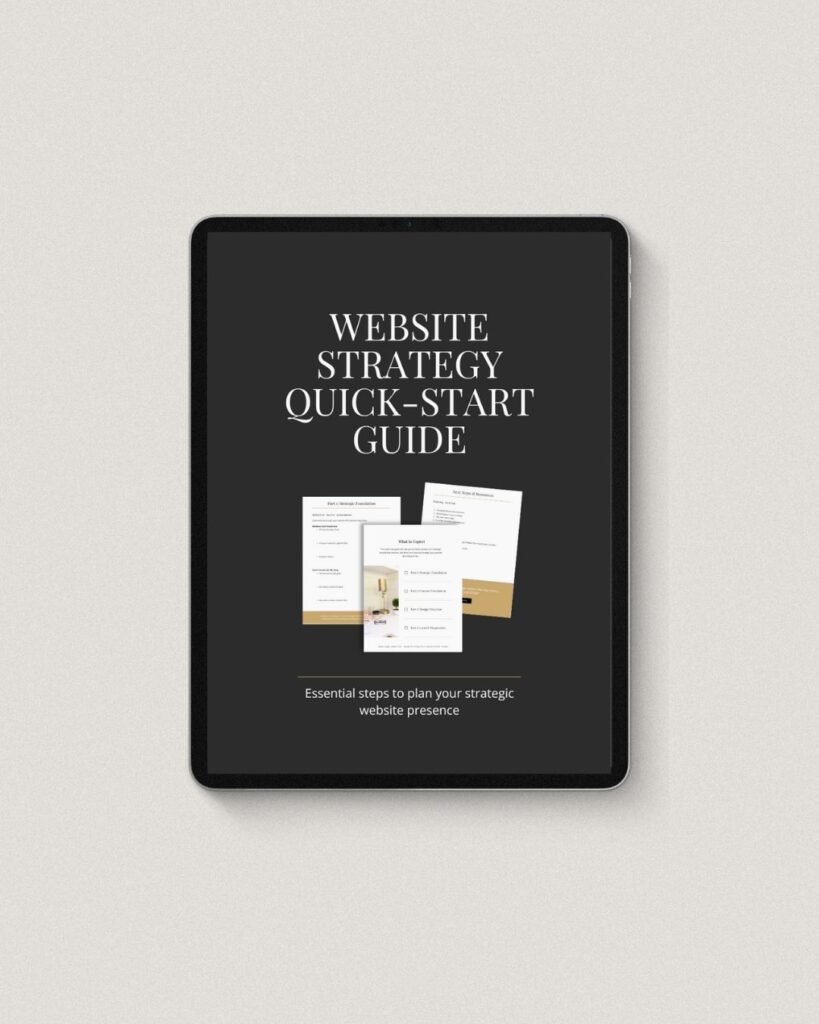Why Most Websites Fail to Convert

Here’s a shocking statistic: 94% of first impressions about your business are design-related, yet the average website converts less than 2.35% of visitors into meaningful actions. The disconnect? Most websites prioritize aesthetics over strategy, leaving business owners with beautiful but ineffective digital storefronts.
One universal truth I have discovered from helping businesses transform their websites is this: Success starts with strategy, not design.
The Hidden Cost of Design-First Websites
When business owners approach website creation, they typically start by gathering design inspiration, choosing color schemes, and browsing templates. Sound familiar? While these elements matter, beginning with design is like choosing the paint color for a house before determining how many bedrooms you need.
Here’s what the data tells us:
- 88% of online consumers are less likely to return to a site after a poor experience
- The average visitor spends less than 15 seconds deciding whether to stay or leave
- 70% of online businesses fail due to poor usability and unclear value propositions
Coaches and Consultants:
- Top-performing coaching websites achieve 5-7% conversion rates on discovery call bookings
- Strategy-focused coaching sites see 25-40% higher email list conversion rates than design-focused sites
- Coaching websites with clear service packages convert 3x better than those with unclear offerings
Photographers and Creatives:
- Photography websites with strategic portfolio organization see 4.2% booking rates vs. 1.8% industry average
- Clear pricing and package pages achieve 2.5x higher inquiry rates
- Strategic email capture points convert 15-20% of portfolio viewers into leads
Course Creators and Educators:
- Education-focused websites with strategic content pathways see 8-12% course enrollment rates
- Clear learning journey maps increase student registration by 180%
- Strategic lead magnets convert 30-45% of website visitors into email subscribers
“The real cost isn’t just in lost visitors—it’s in missed opportunities, wasted marketing spend, and stunted business growth.“
Why Most Websites Fail to Convert
Through analyzing hundreds of business websites, I’ve identified three primary failure points:
1. Missing Strategic Foundation
Most websites lack clear alignment between business objectives and website structure. Without this foundation, even the most beautiful design can’t drive results.
2. Disconnected User Journeys
Websites often force visitors to figure out their own path instead of strategically guiding them toward desired actions. This creates confusion and reduces conversions.
3. Weak Content Architecture
Content is frequently added ad-hoc rather than strategically structured to support the buyer’s journey and business goals.
The Strategy-First Framework
The solution? Start with strategy. Here’s what that looks like:
Step 1: Business Goal Alignment
Before choosing colors or templates, define:
- Primary revenue goals
- Lead generation targets
- Brand positioning objectives
- Success metrics
Step 2: User Journey Mapping
Create clear pathways that guide visitors from their first interaction to desired conversions:
- Entry point identification
- Information hierarchy
- Decision point optimization
- Clear next steps
Step 3: Strategic Content Architecture
Structure your content to support both user needs and business goals:
- Value proposition placement
- Conversion pathway development
- Resource organization
- Call-to-action strategy
“The biggest website mistake isn’t poor design—it’s poor planning.”
Implementing the Strategy-First Approach
Ready to transform your website from a digital brochure into a conversion engine? Start with these foundational steps:
1. Missing Strategic Foundation
- Evaluate your existing conversion rates
- Identify content gaps
- Map current user flows
- Document pain points
2. Define Your Strategic Foundation
- Set clear business objectives
- Establish success metrics
- Create user personas
- Plan conversion pathways
3. Build Your Content Framework
- Develop your core message
- Plan content hierarchy
- Structure information flow
- Design conversion points

Want to dive deeper? Download our free Website Strategy Quick-Start Guide to access detailed planning frameworks and implementation steps.
Measuring Success: The ROI of Strategic Websites
When businesses implement a strategy-first approach to website design, the impact can be transformative. Industry research shows that strategically planned websites consistently outperform their design-first counterparts across key metrics:
Key Performance Indicators
- Conversion Optimization: Strategic websites typically achieve 2-3x higher conversion rates compared to industry averages
- User Engagement: Properly structured content and clear user pathways can reduce bounce rates by up to 40%
- Lead Quality: Strategic alignment between content and business goals often results in better qualified leads
- Customer Journey: Improved user flows can increase the percentage of visitors reaching key conversion pages by 50%
What to Monitor
To measure the success of your strategic website, focus on these key metrics:
- Conversion Rate by Goal: Track specific actions like email signups, consultation bookings, or product inquiries
- User Behavior: Monitor time on site, pages per session, and navigation patterns
- Content Performance: Measure which strategic content pieces drive the most conversions
- Lead Quality: Assess how well your website pre-qualifies potential clients
The key to success? Starting with strategy before design, ensuring every element of your website works together to support your business goals.
Taking Action: Your Next Steps
The path to a high-converting website starts with strategy, but you don’t have to figure it out alone. Here’s how to begin:
1. Download our free Website Strategy Quick-Start Guide to access:
- Strategic planning frameworks
- Implementation checklists
- Success metrics templates
- Quick-win action items
2. Join our email list for insights on:
- Strategic website optimization
- Conversion rate improvements
- Content strategy development
- Launch preparation tips and more!
Remember: Your website isn’t just a digital business card—it’s a strategic tool for business growth. Start with strategy, and the results will follow.
If this blog post inspires you, I would love to hear your thoughts. Join Kim on Instagram, @mayandjamesco.
Thanks for your support!